

17. Syntheses and uses of isotopically labelled compounds |
999 |
3.Synthesis of [ 18F]4-fluoroantipyrine (292)
(a)292, an important blood flow tracer especially useful in multitracer radiography313, has been synthesized314 as shown in equation 162. The simplicity of the methods allows a remotely operated synthesis for day-to-day operation315.
|
|
|
|
18 F |
|
Me |
|
|
Me |
|
|
||
|
|
|
|
H |
|
OOCCH3 |
|
|
N |
CH3COOF[18F] |
|
|
|
|
|
|
|
|
N |
|
O |
N |
Me |
|
|||
|
|
|
O |
N |
Me |
|
|
|
|
|
|||
|
Ph |
|
|
|
|
|
|
|
|
|
Ph |
|
|
|
|
|
|
|
|
|
(162)
18F M e
Base
N
O N Me
Ph
(292)
(b) 292 has been synthesized also315 by direct fluorination of the corresponding silane (equation 163). As to the mechanisms of reactions 162 and 163, it has been suggested315 that reaction 163 proceeds through the intermediate 293. The initial electrophilic addition by fluorine at C 4 is followed by elimination of trimethylsilane probably by F and electron shift. A 14C KIE study of the last reaction step in equation 163 should clarify the above mechanistic suggestions concerning timing of bonding changes in TS.
Me
N
O N Me
Ph
Br Me
Br2 /A cOH
N
O N Me
Ph
Me3 Si Me
O |
|
N |
N |
Me |
|
|
|
|
|
Ph |
|
1. n-BuLi, Et2 O; 2. Me3 SiCl
(163)
|
18 F |
|
Me |
CCl3 F |
|
|
|
-78˚C, [18 F]F2 |
O |
|
N |
|
N |
Me |
|
|
|
|
Ph
(292)
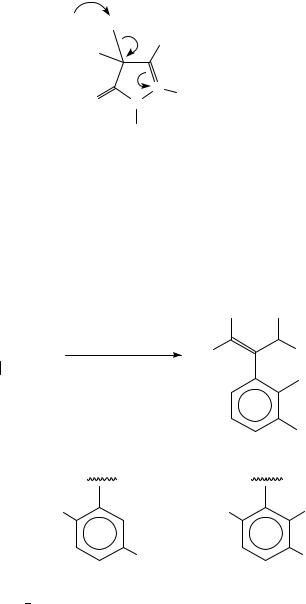
1000 |
Mieczysław Ziełinski´ and Marianna Kanska´ |
|
|
−F |
SiMe3 |
|
|
|
|
F |
Me |
|
|
|
|
|
N+ |
|
O |
Me |
|
N |
|
Ph
(293)
4. Synthesis of 18F-labelled (E)-ˇ-fluoromethylene-DL-m-tyrosine (FMMT, 294)
2-Fluoro-FMMT, 294, 6-fluoro-FMMT, 295, and 2,6-difluoro-FMMT, 296, labelled with 18F, have been obtained316 in the direct reaction317 of 297 with AcO18F38
(equation 164). The specific activity at the end of 60 min preparation time was about 200 mCi/mmol. The HPLC purification yields a radiotracer which can be directly injected after sterilization for the assessment of presynaptic CNS dopamine nerve terminals using PET319.
CHF

 [18F]A cOF in krypton gas m-HOC6 H4 CCHCOOH
[18F]A cOF in krypton gas m-HOC6 H4 CCHCOOH
NH2
(297)
|
9 |
|
H |
COOH |
|
10 |
8 |
|
7 |
||
|
||
F |
NH2 |
1 18F
2
3
OH (164)
(294)
18F |
18F |
18F |
+ |
+ |
|
OH |
|
OH |
(295) |
|
(296) |
The structures of 294 296 have been resolved unambiguously by fast atom bombardment mass spectrometry and 1H-, 13C- and 19F- NMR spectroscopic studies316.
5. Synthesis of 6-deoxy-6-[18F]fluoro-L-ascorbic acid ( 18F-DFA, 298)
298, needed for imaging in vivo the biochemical functions of antioxidants in humans, has been obtained320 in one-pot synthesis via nucleophilic displacement of cyclic sulphate
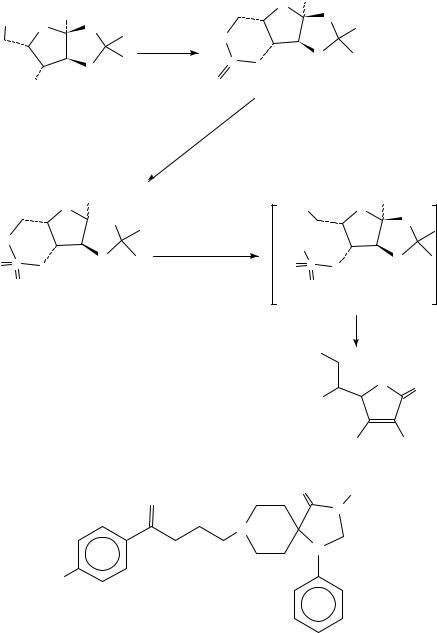
17. Syntheses and uses of isotopically labelled compounds |
1001 |
with no-carrier-added [18F]fluoride ion (equation 165).
|
|
|
|
O |
COOMe |
|
|
COOMe |
|
O |
|
OH |
O |
|
|
||
O |
|
|
|
||
|
O |
|
|
||
|
|
|
|
|
|
|
|
SOCl2 |
/ Et3 N |
|
O |
|
|
O |
S |
O |
|
|
|
|
|||
|
|
|
|
||
|
HO |
|
O |
|
|
2,3 -O-isopropylidene-2-keto-L-gulonate |
|
|
|||
|
|
|
RuCl3 / Na IO4 |
|
|
|
|
|
CCl4 / MeCN / H2 O |
|
|
COOMe
O
 O
O
O
Me4 N18 F, MeCN, 80°C
O
O S O
O
O
N
18 F |
O |
COOMe |
|
|
|
O |
|
|
|
|
|
−O |
|
|
|
O S |
O |
O |
|
|
|
||
O |
|
|
|
|
40% H2 SO4 |
|
|
18 F |
|
|
|
|
|
O |
O |
|
|
|
|
HO |
|
|
|
|
HO |
|
OH |
(298)
(165)
O R
N
N
F
(299a) R = CH2 CH2 18 F, (299b) R = CH2 CH2 19 F, (299c) R = H
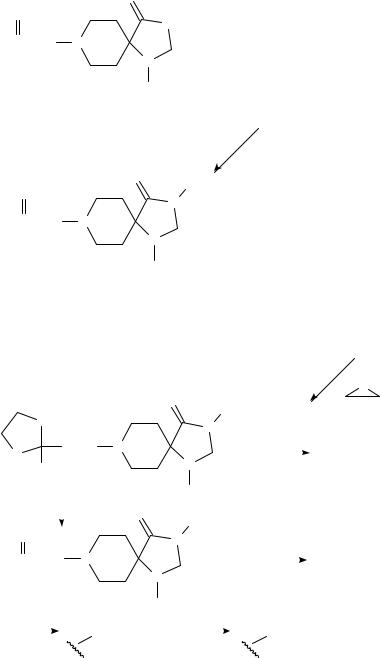
1002 |
|
|
|
|
|
|
Mieczysław Ziełinski´ and Marianna Kanska´ |
|
|
|
|
|
|
|
|
|
|
|
|
|
|||||||||||||||||||||
|
|
|
|
|
|
|
|
|
O |
|
|
|
|
|
|
|
|
|
|
|
|
|
|
|
|
|
|
|
|
|
|
|
|
|
|
|
|
|
|
|
|
|
|
R1 |
|
|
|
|
|
|
|
|
|
|
N |
|
|
|
|
|
|
|
|
|
|
|
|
|
|
|
|
|
|
|
|
|
|
|
|
|
|||
|
|
|
|
|
|
|
|
|
|
|
|
|
|
|
|
|
|
|
|
|
|
|
|
|
|
|
|
|
|
|
|
|
|
|
|
|
|
|
|||
p-FC6 H4 C(CH2 )3 |
N |
|
|
|
+ |
R2CH2 CH2 R2 |
|
|
|
|
|
|
|
|
|
|
|
|
|
||||||||||||||||||||||
|
|
|
|
N |
|
|
|
|
|
|
|
|
|
|
|
|
|
||||||||||||||||||||||||
|
|
|
|
|
|
|
|
|
|
|
|
|
|
|
|
|
|
|
|
|
|
|
|
|
|
|
|
|
|
|
|
|
|
|
|
|
|
|
|||
(300a) |
1 |
= O, |
|
|
|
|
|
|
|
|
(301a) |
|
|
2 |
= |
|
Br, (301b) |
2 |
= |
|
|
|
|
|
|
||||||||||||||||
R |
|
|
|
|
Ph |
|
R |
|
|
R |
|
SO3 Me |
|||||||||||||||||||||||||||||
(300b) |
1 |
= O(CH2 )2 O |
|
|
|
|
(301c) |
|
|
2 |
= |
|
|
|
|
|
|
|
|
|
|
|
|
|
|
|
|
|
|
||||||||||||
R |
|
|
|
|
R |
|
|
|
|
|
SO3 C6 H4 Me |
|
|
|
|
|
|
|
|
||||||||||||||||||||||
|
|
|
|
|
|
|
|
|
|
|
|
|
|
|
|||||||||||||||||||||||||||
|
|
|
|
|
|
|
|
|
|
|
|
|
|
|
(301d) R2 = |
|
|
|
SO3 C6 H2 Me3 − 2,4,6 |
|
|
|
|
||||||||||||||||||
|
|
|
|
|
|
|
|
|
|
|
|
|
|
|
|
|
|
|
|
|
|||||||||||||||||||||
|
|
|
|
|
|
|
|
|
|
|
|
|
|
|
|
|
|
|
|
|
|
|
|
|
|
NaOH / Bu4 NHSO4 |
|
|
|
|
|
|
|
|
|||||||
|
|
|
|
|
|
|
|
|
O |
|
|
|
|
|
CH2 CH2 R2 |
|
|
|
|
|
|
|
|
|
|
|
|
|
|||||||||||||
|
|
|
R1 |
|
|
|
|
|
|
|
|
|
|
|
|
|
|
|
|
|
|
|
|
|
|
|
|
|
|||||||||||||
|
|
|
|
|
|
|
|
|
|
|
|
|
N |
|
|
|
|
|
|
|
|
|
|
|
|
|
|
|
|
|
|
|
|
|
|
|
|
|
|||
|
|
|
|
|
|
|
|
|
|
|
|
|
|
|
|
|
|
|
|
|
|
|
|
|
|
|
|
|
|
|
|
|
|
|
|
|
|
|
|||
p-FC6 H4 C(CH2 )3 |
|
N |
|
|
|
|
|
|
|
|
|
|
|
|
|
|
|
|
|
|
|
|
|
|
|
|
|
|
|
|
|
|
|
||||||||
|
|
|
|
|
|
|
|
|
|
|
|
N |
|
|
|
|
|
|
|
|
|
|
|
|
|
|
|
|
|
|
|
|
|
|
|
|
|
|
|
|
|
|
|
|
|
|
|
|
|
|
|
|
|
Ph |
|
|
|
|
|
|
|
|
|
|
|
|
|
|
|
|
|
|
|
|
|
|
|
|
|
|
|
|
|
(302a) |
2 |
= |
1 |
= O; |
|
|
|
(302b) R |
2 |
|
= |
|
|
|
|
1 |
= O; |
|
|
|
|
|
|
|
|
||||||||||||||||
R |
Br, R |
|
|
|
|
|
|
|
|
|
SO3 Me, R |
|
|
|
|
|
|
|
|
||||||||||||||||||||||
|
2 |
|
|
|
|
1 |
|
|
|
|
|
|
|
|
|
2 |
|
|
|
|
|
|
|
|
|
|
|
|
|
|
1 |
|
|
|
|||||||
(302c) |
R |
= |
SO3 C6 H4 Me-p, R = |
O; |
(302d) |
R |
|
|
= |
|
|
|
|
SO3 C6 H2 Me3 -2, 4, 6; R |
|
= O; |
|||||||||||||||||||||||||
|
|
|
|
|
|
|
|||||||||||||||||||||||||||||||||||
(302e) |
2 |
= |
1 |
= |
|
|
|
|
|
|
(302f) |
|
|
2 |
|
= |
|
|
|
|
|
|
|
1 |
= |
|
|
|
|
|
|
|
|
|
|
||||||
R |
Br, R |
|
O(CH2 )2 O |
|
|
; |
R |
|
|
|
|
|
|
SO3 Me , R |
|
|
|
|
O(CH2 )2 O |
|
; |
||||||||||||||||||||
|
2 |
|
|
|
|
1 |
|
|
|
|
|
|
|
|
|
|
|
|
|
|
|
|
|
|
|
|
|
|
|
|
|
|
|
|
|
|
|
|
|||
(302g) |
R |
= −SO3 C6 H4 Me-p, R = |
|
|
O(CH2 )2 O |
|
|
|
; |
|
|
|
|
|
|
|
|
|
|
|
|
|
|
|
|
|
|
|
|
||||||||||||
|
2 |
|
|
|
|
|
|
|
|
1 |
|
|
|
|
|
|
|
|
|
|
|
|
|
|
|
|
|
|
|
|
|
|
|
|
|
|
|
|
|
||
(302h) |
R |
= −SO3 C6 H2 Me3 -2,4,6; R = |
|
O(CH2 )2 O |
|
|
|
; |
|
|
|
|
|
|
|
|
|
|
|
|
|
|
|
||||||||||||||||||
|
|
|
|
|
|
|
|
|
|
|
|
|
|
|
|
|
|
|
|
|
|
|
|
|
|
1. NaOH / Bu4 HSO4 |
|
|
|
|
|||||||||||
|
|
|
|
|
|
|
|
|
|
|
|
|
|
|
|
|
|
|
|
|
|
|
|
|
|
|
|
|
|
|
|
|
|
2. |
O |
||||||
|
|
|
|
|
|
|
|
|
|
|
|
|
|
|
|
|
|
|
|
|
|
|
|
|
|
|
|
|
|
|
|
|
|
|
|
|
|
||||
|
|
|
|
|
|
|
|
|
|
|
|
|
|
O |
|
|
|
|
CH2 CH2 OH |
|
|
|
|
|
|
|
|
|
|
|
|
|
|||||||||
|
|
|
|
O |
|
|
|
|
|
|
|
|
|
|
|
|
|
|
|
|
|
|
|
|
|
|
|
|
|
|
|
||||||||||
|
|
|
|
|
|
|
|
|
|
|
|
|
|
N |
|
|
|
|
|
|
|
|
|
|
|
|
|
|
|
|
|
|
|
|
|
||||||
|
|
|
|
|
|
|
|
|
|
|
|
|
|
|
|
|
|
|
|
|
|
|
|
|
|
|
|
|
|
|
|
|
|
|
|
|
|
||||
|
O |
|
|
(CH2 )3 N |
|
|
|
|
|
|
|
|
|
|
|
|
|
|
|
|
|
(MeSO2 )2 O |
|
|
|
|
302f |
|
|
|
|
||||||||||
|
C6 H4 F-p |
|
|
|
|
|
N |
|
|
|
|
|
|
|
|
|
|
|
|
|
|
|
|
|
|
|
|
|
|||||||||||||
|
|
|
|
|
|
|
|
|
|
|
|
|
|
|
|
|
|
|
|
|
|
|
|
|
|
|
|
|
|
|
|
|
|
||||||||
|
|
|
|
|
|
|
|
|
|
|
|
|
|
|
|
|
|
|
|
|
|
|
|
|
|
|
|
|
|
|
|
|
|
|
|||||||
|
|
|
|
|
|
|
H+ |
|
|
|
|
|
Ph |
|
|
|
|
|
|
|
|
|
|
|
|
|
|
|
|
|
|
|
|
|
|
|
|
|
|||
|
|
|
|
|
|
|
|
|
|
|
|
|
|
|
|
|
|
|
|
|
|
|
|
|
|
|
|
|
|
|
|
|
|
|
|||||||
|
|
|
|
|
|
|
|
|
|
|
|
|
|
|
|
|
|
|
|
|
|
|
|
|
|
|
|
|
|
|
|
|
|
|
|
|
|
||||
|
|
|
|
|
|
|
|
|
O |
|
|
|
|
|
CH2 CH2 OH |
|
|
|
|
|
|
|
|
|
|
|
|
|
|||||||||||||
|
|
|
O |
|
|
|
|
|
|
|
|
|
|
|
|
|
|
|
|
|
|
|
|
|
|
|
|
|
|||||||||||||
|
|
|
|
|
|
|
|
|
|
|
|
|
N |
|
|
|
|
|
|
|
|
|
|
|
|
|
|
|
|
|
|
|
|
|
|
|
|
|
|||
p-FC6 H4 C (CH2 )3 |
|
N |
|
|
|
|
|
|
|
|
|
|
|
|
|
|
|
(CH3 SO2 )2 O |
|
|
|
302b |
|
|
|
|
|||||||||||||||
|
|
N |
|
|
|
|
|
|
|
|
|
|
|
|
|
|
|
|
|
|
|
|
|
|
|
||||||||||||||||
|
|
|
|
|
|
|
|
|
|
|
|
|
|
|
|
|
|
|
|
|
|
|
|
|
|
|
|
|
|
|
|
|
|
|
|
|
|
|
|
||
|
|
|
|
|
|
|
|
|
|
|
|
Ph |
|
|
|
|
|
|
|
|
|
|
|
|
|
|
|
|
|
|
|
|
|
|
|
|
|
||||
302e |
|
|
Me3 N |
+ |
|
|
|
− A gClO4 |
|
|
|
|
|
|
|
|
|
+ |
|
|
|
|
− |
|
|
|
|||||||||||||||
|
|
|
|
|
|
|
|
CH2 CH2 NMe3 Br |
|
|
|
|
|
|
|
|
|
|
|
|
CH2 CH2 NMe3 ClO4 |
|
|
|
|
||||||||||||||||
|
|
|
|
|
|
|
|
|
|
|
|
|
|
|
|
|
|
|
|
||||||||||||||||||||||
|
|
|
|
|
|
|
(303) |
|
|
|
|
|
|
|
|
|
|
|
|
|
|
|
|
|
|
|
(304) |
|
|
|
|
|
|||||||||
(166)
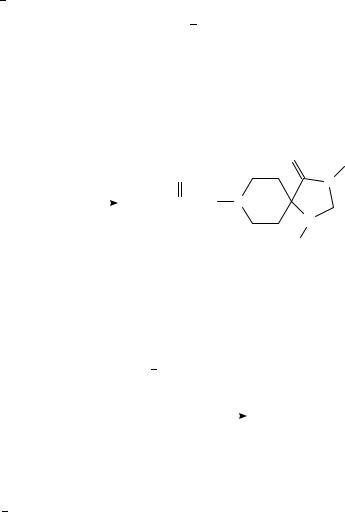
17. Syntheses and uses of isotopically labelled compounds |
1003 |
The biodistribution study of 18F-DFA in normal rats has shown high uptake of radioactivity in the adrenals, kidneys, liver and small intestine organs, possessing high concentration of L-ascorbic acid in cells320,321. A certain uptake of radioactivity of the brain has been observed also between 10 and 120 min after in vivo injection322. 298 is able to accumulate in the tumor of mice bearing 3-methylcholanthrene induced fibrosacroma320. It has been suggested320,323 that ascorbic acid may have some roles in the prevention or treatment of cancer323.
6. Synthesis of 3-(20-[18F]fluoroethyl)spiperone) (299a)
299a, useful for imaging the brain dopamine receptor system in vivo by PET, has been synthesized324 from 300a and 301, ketalization of 302 and treatment of the products 302f h (equation 166) with NCA K18F/Kryptofix in MeCN at 100 °C for 15 min. The tomographic behaviour of 299 in human brain tissue was found to be consistent with the labelling of dopamine D-2 receptors325 327. X-ray analysis using 299b unequivocally established that the flouroethyl group resides on the amide nitrogen. The compound 299b was given also a detailed IR, NMR and MS investigation324.
6. Synthesis of NCA N-([18F]fluoroalkyl)spiperone derivatives (305 and 306)
3-N-([18F]fluoroalkyl)spiperone derivatives 305 and 306 have been prepared328 by N- alkylation of spiperone 299c with fluoroalkyl halides (equation 167).
|
|
|
|
|
|
|
|
|
|
O |
[18F]R |
||
|
|
|
|
|
|
|
O |
|
|
|
|
|
|
|
|
|
|
|
|
|
|
|
|
|
|
N |
|
|
[18F] alkyl halide |
|
|
|
|
|
|
|
|
|
|||
299c |
|
|
p-FC6 H4 C(CH2 )3 |
N |
|
|
|
|
|
||||
n-Bu4NOH, o-DCB |
|
|
|
|
|
|
N |
||||||
|
|
|
|
|
|
|
|
|
|
||||
|
|
|
|
|
|
|
|
|
|
|
|
|
|
|
|
|
|
|
|
|
|
|
|
Ph |
(167) |
||
|
|
|
|
|
|
|
|
|
|
|
|
|
|
|
(305a) |
R = |
|
|
|
CH2 CH2 18F, |
(306a) |
R = |
|
|
|
CH2 CH(18F)Me |
|
|
|
|
|
|
|
||||||||
|
(305b) |
R = |
|
|
|
(CH2 )3 |
18F, |
(306b) |
R = |
|
|
|
CH2 CH(18F)Et |
|
|
|
|
|
|
|
|||||||
|
(305c) |
R = |
|
|
|
(CH2 )4 |
18F, |
(306c) |
R = |
|
|
|
CH2 CH(18F)Pr-n |
|
|
|
|
|
|
|
|||||||
|
|
|
|
|
|
|
|
(306d) |
R = |
|
|
|
CH2 CH(18F)But-n |
|
|
|
|
|
|
|
|
|
|
|
|||
o-DCB = 1,2-dicyanobenzene
The fluoroalkylating agents 307 309 have been prepared from the corresponding trifluoromethanesulphonates by [18F]fluoride (equation 168).
|
18F − , n- Bu4NOH |
|
BrCH2 (CH2 )nOTf |
|
BrCH2 (CH2 )n18 F |
|
||
THF
(307) |
n = 1 |
(168) |
(308) |
n = 2 |
|
(309) |
n = 3 |
|
Synthesis of 2-[18F]fluoroalkyl (Et, Pr, But, pentyl and hexyl) spiperone derivatives, 306a d, involved iodo[18F]fluorination of terminal olefins (equation 169) followed by

1004 |
Mieczysław Ziełinski´ and Marianna Kanska´ |
N-alkylation of spiperone329.
CH2 |
|
CHR |
18 F −, Η 2SO4 |
ICH2 CH(18 F)R |
(169) |
|
|
||||
|
N-iodosuccinimide, CH2Cl2 solvent |
||||
|
|
|
|
|
R = Me, Et, Pr, But, Pen
The brain uptake efficiency and distribution of the above compounds as well as D2 receptor affinities of derivatives of spiperone containing aliphatic halogens have been
studied also330. |
|
The synthesis of fluorine-18-labelled |
receptor-based radiopharmaceuticals carried |
out before 1986 have been reviewed331 |
and the methods applied for the synthesis |
of 18F-butyrophenone neuroleptics such as spiroperidol (spiperone), haloperidol have been critically evaluated. The synthesis for preparing N-(2-[18F]fluoroethyl)spiperone330 involving the [18F]fluoride ion displacement of a suitable leaving group on the ethyl side chain was found to be particularly good (>50% yield).
Synthesis of 18F-opiates and 18F-steroids have been briefly reviewed also331. Biolog-
ical studies of the above 18F-labelled receptor ligands in animals have been discussed briefly331,332.
The synthesis of 21-[18F]fluoro-16˛-methyl-19-norprogesterone, 21-[18F]fluoro-16˛- ethyl-19-norprogestrone, 21-[18F]fluoro-16˛-methylprogestrone and 21-[18F]fluoro-16˛- ethylprogestrone333 of high specific activity has already been reviewed in this series334.
B. Compounds Labelled with Heavier Radiohalogens
1. Synthesis of 1-(20-fluoro-20-deoxy-ˇ-D-ribofuranosyl)uracil (311) and 1-(20-chloro-
20-deoxy-ˇ-D-ribofuranosyl)uracil (312) radiolabelled with 18F, 34mCl, 38Cl, 14C and
3H
Pyrimidine nucleosides labelled with radiohalogens have been studied for diagnostic335 and therapeutic336 applications in oncology. They may serve as indicators of tissue proliferation suitable for non-invasive tumor localization. 311 and 312 have been radiolabelled for evaluation as diagnostic radiopharmaceuticals337.
6-[3H]-20 -FUdR and 2-[14C]-20 -FUdR have been prepared by reaction of anhydrous hydrogen fluoride (AHF) with 6-[3H]- or 2-[14C]-labelled 2,20 -anhydro-1-ˇ-D- arabinofuranosyl-uracil, 310 (2,20 -AUR) (equation 170a), 6-[3H]-20-ClUdR has been prepared by reaction of CaCl2 with 6-[3H]-2,20 -AUR (equation 170b). Reaction of
[18F]-AHF with 2,20 -AUR, 310, provided 20-[18F]-20 -FUdR, 311, while the reaction of 2,20 -AUR, 310, with [36Cl]NaCl and TFA gave 20-[36Cl]-20 -ClUdR, 312 20 -[34mCl]-20 -
ClUdR has been similarly prepared using [35mCl]MgCl2 or [34mCl] labelled Dowex 21-K anion exchange resin.
2. Synthesis of bromperidol (313) labelled with 75Br and 77Br
313, proved to be effective for the treatment of schizophrenia and to have high affinity to dopamine receptors338 340, has been synthesized341 from the diazotized precursor 314, with NCA 75Br or 77Br (equation 171).
3. Synthesis of radiobrominated spiroperidol (315)
315, directed to DAD2 receptors related to some neuropsychiatric disorders342, has been labelled343 with 75Br, 76Br and 77Br in 80 90% radiochemical yields as shown344
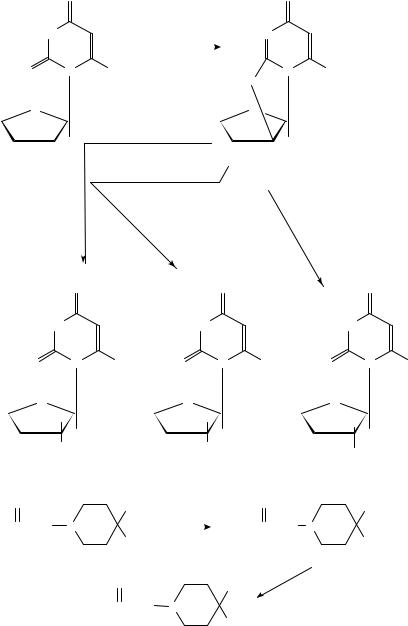
17. Syntheses and uses of isotopically labelled compounds |
1005 |
in equation 172.
O O
|
|
|
|
HN |
|
|
|
DMF,NaHCO3 |
|
|
|
|
N |
|
|
|
|
||||||
|
|
|
|
|
|
|
|
|
|
|
|
|
|
|
|
|
|
|
|
||||
|
|
|
|
|
|
|
|
|
|
|
|
|
|
|
|
|
|
|
|
|
|
||
|
|
|
|
|
|
|
diphenyl carbonate |
|
|
|
|
|
|
|
|
||||||||
|
|
|
|
O |
|
|
N |
|
|
|
|
|
|
|
|
|
|
|
N |
|
|
||
|
|
|
|
|
|
H |
|
|
|
|
|
|
|
|
|
|
O |
|
|
H |
|||
|
|
|
|
|
|
|
|
|
|
|
|
|
|
|
|
|
|
|
|
|
|
|
|
HOCH2 |
O |
|
|
|
|
|
|
|
|
|
HOCH2 |
O |
|
|
|
|
|||||||
|
|
|
|
|
|
|
|
|
|
|
|
|
|
|
|
|
|
|
|
||||
|
|
|
|
|
|
|
|
A HF, dioxane |
|
|
|
|
|
|
|
|
|
|
|||||
|
|
|
|
|
|
|
|
equation 170a |
|
|
|
|
|
|
|
|
|
||||||
|
HO |
|
OH |
|
|
HO |
|
|
|
|
|||||||||||||
|
|
|
|
|
|
|
|
|
|
(310) |
C = 12 C or 14 C |
||||||||||||
|
|
|
|
|
|
|
|
|
|
|
|
|
|
|
|
|
|
|
|
|
|
||
|
|
|
|
|
|
|
|
MClX , DMF, 140-155 °C |
|
|
|
|
|
H = 1H or 3 H |
|||||||||
|
|
|
|
|
|
|
|
M = Na,Mg,Ca,NH4 Dowex 21-K |
|
|
|
|
|
||||||||||
|
|
|
|
|
|
|
|
|
equation 170b |
|
|
|
|
|
|
|
|
|
|||||
|
|
|
|
|
|
|
|
|
|
|
|
|
|
|
|
|
|
|
|
|
aq.acid or base |
||
|
|
|
|
|
|
|
|
|
|
|
|
|
|
|
|
|
|
|
|
|
heat |
||
|
|
|
|
|
|
|
O |
|
|
|
|
|
|
|
O |
|
|
|
|
|
|||
|
|
|
|
HN |
|
|
|
|
|
|
HN |
|
|
|
|
|
|
|
|
HN |
|||
|
|
|
|
|
|
|
|
|
|
|
|
|
|
|
|
|
|
|
|
|
|
|
|
|
|
|
|
O |
|
|
N |
|
|
|
|
|
O |
N |
|
|
|
O |
|||||
|
|
|
|
|
|
H |
|
|
|
|
|
H |
|
|
|
||||||||
HOCH2 |
O |
|
|
|
|
HOCH2 |
O |
|
|
|
|
|
HOCH2 O |
||||||||||
|
|
|
|
|
|
F |
|
|
|
|
|
|
Cl |
|
|
|
|
HO |
|||||
|
|
|
|
|
|
|
|
|
|
|
|
|
|
|
|||||||||
|
|
|
|
|
|
|
|
|
|
|
|
|
|
|
|
|
|||||||
|
|
HO |
|
|
HO |
|
|
HO |
|||||||||||||||
(311) F = 19 F or 18 F |
(312) Cl =34mCl or 38Cl |
|
|
|
|
||||||||||||||||||
|
|
O |
|
|
|
|
|
OH |
|
|
|
|
|
O |
|
|
|
|
|||||
|
|
|
|
|
|
|
|
|
|
|
|
|
|
|
|
|
|
|
|||||
p-FC6 H4 C(CH2 )3 |
|
|
N |
|
|
|
H2 SO4 |
,NaNO2 |
|
|
p-FC6 H4 C(CH2 )3 |
N |
|||||||||||
|
|
|
|
|
|
|
|
|
|
|
|||||||||||||
C6 H4 NH2 -p
(170)
O
N H
OH
+ _
C6 H4 N2 HSO4
|
|
|
|
(314) |
|
|
|
|
(171) |
O |
|
OH |
|
− |
|
|
|
Br /Cu powder |
|
p-FC6 H4 C(CH2 )3 |
N |
|
|
|
|
|
|
|
|
|
|
C6 H4 Br-p |
|
|
(313)

1006 |
Mieczysław Ziełinski´ and Marianna Kanska´ |
O
O
NH
p-FC6 H4 C(CH2 )3 N
N
Ph
(315)
(172)
Br ,HOA C/H2 O2
O
O |
NH |
|
p-FC6 H4 C(CH2 )3 N
N
C6 H4 Br-p
[76Br]-p-bromospiroperidol (BŁ SP) and [77Br]-p-bromospiroperidols have been used to determine non-invasively the time course of the uptake and the time course of the binding of p-bromospiroperidol in striatum and cerebellum of a rhesus monkey by PET and in rat striatum, frontal cortex and cerebellum, and the striatum to cerebellum uptake ratio345.
4. Synthesis of f(Z ) and (Z ,E )-(1-[ 82Br]bromo-1-penten-5-yl)gtriphenylphosphonium cations (316)
316-Z has been obtained346 from 317-Z347, and phenylphosphine, 318 (equation 173). Similarly, condensation of 319 synthesized by bromodemercuration of 320348 with 318 provided 321 (equation 174).
H |
H PPh3 , 318 |
+ |
|
|
|
|
|
|
|
|
|
|
||||
|
|
|
|
|
|
Ph3 P(CH2 )3 CH |
|
CHBr |
|
|
|
|
||||
|
|
|
|
|
|
|
|
|
|
|
||||||
|
|
|
|
|
|
(173) |
||||||||||
I(CH ) |
|
|
|
|
|
|
|
|
|
|||||||
|
Br |
|
|
8 2 Br |
|
|
|
|||||||||
2 |
3 |
|
|
|
|
|
|
Br = |
|
|
|
|
||||
(317) - Z |
|
|
(316) - Z |
|
|
|
|
|
|
|||||||
|
H |
|
|
|
|
|
|
|
|
|
|
|
|
|||
|
HgBr |
|
|
|
|
|
|
+ |
|
|
|
|||||
|
|
|
|
|
|
I(CH2 )3 CH |
|
|
318 |
|
|
|||||
I(CH2 )3 |
|
|
|
|
|
CHBr |
|
|
Ph3 P(CH2 )3 CH |
|
CHBr |
|||||
H |
|
|
|
|
||||||||||||
|
|
|
|
|
|
|
|
|
|
|
||||||
|
(320) |
|
|
|
|
(319) |
|
|
|
|
|
(321) - Z / E |
(174) |
|||
|
|
|
|
|
|
|
|
|
|
|
|
|
|
|
|
|
The structure of the 321-Z/E mixture was confirmed by single-crystal X-ray analysis349. Both the cis isomer[82Br], 316, and the cis/trans mixture [82Br]-321-Z/E showed high myocardial extraction350 due to the trans membrane potential gradient and high heart/blood ratios346. This suggests that the corresponding 75Br (half-life D 101 min) and 76Br (half-life D 15.9 h) labelled agents could be good candidates for myocardial imaging by PET.
5. Synthesis of (E )-5-(2-[ 82Br]bromovinyl)-1-(2-deoxy-2-fluoro-ˇ-D-ribofuranosyl) uracil (322)
[82Br]BVFRU, 322, has been synthesized351 from CVFRU, 323 (equation 175).
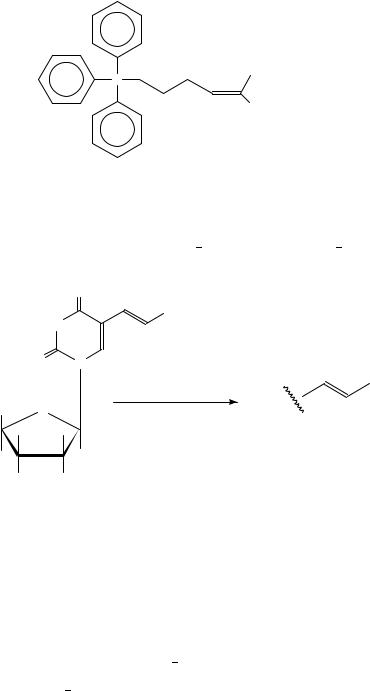
17. Syntheses and uses of isotopically labelled compounds |
1007 |
Br Z (cis)
P
Br E (trans)
(321) - Z / E
The antiviral activity of 322, determined351 using primary rabbit kidney cells injected with HSV-1 (Herpes Simplex Virus type 1), showed that BVFRU has antiviral potency and transport characteristics suitable for in vivo diagnosis of HSE (Herpes Simplex Encephalities) because of greater stability of bromine carbon bonds than iodine carbon bond present in [131I]IVDU352, [(E)-5-(2-iodovinyl)-1-(2-deoxy-ˇ-D-ribofuranosyl)uracil].
|
O |
|
|
COOH |
|
|
HN |
|
O |
N |
|
|
|
8 2 Br |
|
8 2 Br−/chloramine T / A cOK |
|
HOCH2 O |
|
|
|
(322) |
(175) |
OH |
F |
|
(323) |
|
|
6. Synthesis of organic acids labelled with 125I in pivalic acid melt
Radioiodination by isotope exchange with Na125I in a melt of pivalic acid, Me3CCOOH, has been applied353 for the synthesis of a wide variety of compounds labelled with 125I and with 123I, currently the iodine nuclide of choice for scintigraphic imaging. The exchange reactions, proceeding rather by electrophilic than by nucleophilic mechanisms,
were completed within 1 |
|
3 hours at 155 °C. |
aids 324 have been radioiodinated in |
|||
|
||||||
ω-(3-Amino-2,4,6-triiodophenyl)alkanoic |
||||||
59 |
|
99% yields. |
|
|
||
|
|
|
||||
Esterification of glycerol with acids 324a |
|
324e provided a series of mono-, di - and |
||||
|
||||||
trisubstituted triacylglycerols (325) in 70 99% radiochemical yields labelled with 125I, Cholesteryl-ω-(3-amino-2,4,6-triiodophenyl)alkanoates have been 125I-labelled in pivalic acid, also in high 94 98% yields.
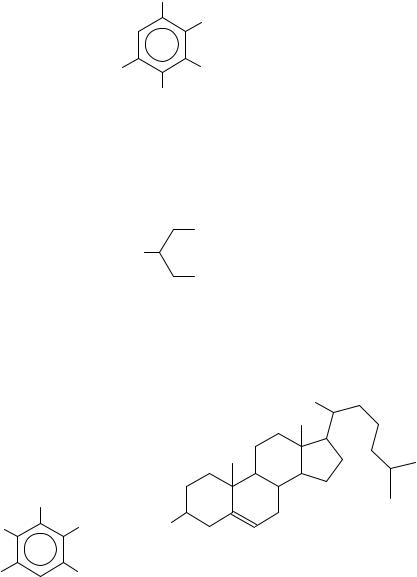
1008 Mieczysław Ziełinski´ and Marianna Kanska´
I
(CH2 )nCH(R)COOH
|
|
|
|
|
I |
|
I |
|
|
NH2 |
|
(324) (a) |
n = 0, |
R = H, |
exchange time = 2 h, yield = 59% |
(b) |
n = 1, |
R = H, |
t = 1 h , yield = 99% |
(c) |
n = 1, |
R = Et, |
t = 1 h , yield = 98% |
(d) |
n = 10, |
R = H, |
t = 1 h , yield = 99% |
(e) |
n = 15, |
R = H, |
t = 3 h , yield = 59% |
|
|
|
(plus 31% side products) |
|
|
|
OR2 |
|
R1O |
|
|
|
|
|
OR2 |
(325a) |
R1 corresponds to acyl groups listed under 324 and R2 to palmitate |
(325b) |
or R1 palmitate, R2 = acyl groups listed under 324 |
(325c) |
R1 = R2 = 324b (92% yield after 2 h) |
324c (70% yield after 6 h)
324d (93% yield after 1.5 h)
324e (80% yield after 2 h)
|
|
|
|
I |
|
H2 N |
(CH2 )nCH(R)COO |
|
|
|
|
I |
I |
|
|
|
|
|
|
I = 12 5 I |
|
(326a) n = 1, R = H, 94% yield after 1 h |
|
|
(326b) n = 1, |
R = Et, 98% yield after 1 h |
|
(326c) n = 10, |
R = H, 95% yield after 3 h |
